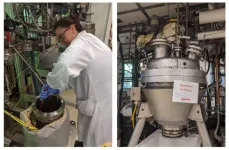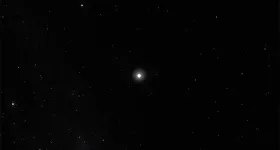(Press-News.org) Neurological disorders are the number one cause of disability in the world, leading to seven million deaths each year. Yet few treatments exist for these diseases, which progressively diminish a person's ability to move and think.
Now, a new study suggests that some of these neurological disorders share a common underlying thread. Staufen1, a protein that accumulates in the brains of patients with certain neurological conditions, is linked to amyotrophic lateral sclerosis (ALS), or Lou Gehrig's disease, along with other neurological disorders, including Alzheimer's, Parkinson's, and Huntington's disease, according to University of Utah Health scientists.
The findings connect Staufen1 to the emerging concept that neurodegenerative diseases are linked to malfunctions in the way cells cope with cellular stress. These results, based on laboratory studies of human tissue and mouse models, suggest that targeting Staufen1 could eventually lead to therapeutic interventions for a number of these disorders.
The study appears in Annals of Neurology.
"Neurodegenerative diseases are a major cause of morbidity and mortality," says Stefan Pulst, M.D., Dr. Med, chair of the Department of Neurology at the University of Utah School of Medicine and senior researcher on the study. "Unfortunately, at this time, we have few, if any, disease-modifying therapies. This finding provides new insight into the pathogenesis of these disorders and potentially provides us with a new target for treatment."
In previous research, the scientists found that Staufen1 accumulates in cells of patients with ALS and cerebellar ataxia, a rare condition that causes patients to lose control of movement. They found that Staufen1 binds to a protein that is both a risk factor for ataxia and a risk factor for ALS. Together, along with other proteins, they form dense disease-related clusters called stress granules that can disrupt normal cellular function. However, when Staufen1 was lowered in the brains of mice, it not only improved the pathology of disease but also rid cells of stress granules.
In their new study, Pulst and colleagues sought to determine if Staufen1 overabundance was a factor in the development of other neurological disorders. To do it, they conducted laboratory experiments on skin cells and spinal cord tissues collected from 12 patients with several different neurodegenerative diseases. They also examined the effects of Staufen1 on neurodegeneration in two animal models.
"We found that Staufen1 protein levels were vastly increased in all of the disease models we examined," Pulst says. "In our laboratory animals, levels of this protein were three- to five-fold higher than in control animals. That's not subtle. If a protein is changed that much, it probably isn't good for any cell, particularly a neuron."
Digging deeper, the researchers found that Staufen1 has an important interaction with another protein called mTOR, a master regulator of many functions in the body that plays a key role in a process called autophagy. Autophagy, or "self-digestion," is a self-preservation mechanism that the body uses to remove dysfunctional cells.
The new study suggests that the complex relationship between Staufen1, mTOR, and autophagy could be a driving factor in the onset of several neurogenerative diseases, according to Daniel Scoles, Ph.D., study co-author and associate professor of neurology at U of U Health.
"When Staufen1 is increased, it actually impairs autophagy," Scoles says. "But we also know that autophagy can degrade Staufen1. It's a vicious cycle that can have a bad outcome for patients."
Based on these findings, Pulst and Scoles are hopeful that they can develop a medication to reduce Staufen1 levels in people at risk for sporadic ALS, the most common form of ALS, in which the causes of the disease are unknown.
If lowering Staufen1 is effective for ALS, it could eventually lead to new therapeutic approaches for the treatment of Alzheimer's disease and other Staufen1-related disorders, the researchers say.
INFORMATION:
In addition to Drs. Pulst and Scoles, U of U Health scientists Sharan Paul, Warunee Dansithong, Karla P. Figueroa, and Mandi Gandelman contributed to this research. The study, "Staufen1 in Human Neurodegeneration appears in the Annals of Neurology. The National Institute of Neurological and Stroke, Target ALS Foundation and Harrington Discovery Institute supported this research.
ITHACA, N.Y. - Since state austerity policies initiated a potable water crisis seven years ago in Flint, Michigan, public health monitoring has focused on potential developmental deficits associated with lead exposure in adolescents or fetuses exposed in utero.
New research from Cornell and the University of Michigan offers the first comprehensive evidence that the city's adult residents suffered a range of adverse physical and mental health symptoms potentially linked to the crisis in the years during and following it, with Black residents affected disproportionately.
In a survey of more than 300 residents, 10% reported having been diagnosed by a clinician with elevated ...
PASADENA, Calif. -- The numbers of recommended vaccine doses, including measles vaccine, administered to children decreased dramatically after the declaration of a national state of emergency on March 13, 2020, due to the COVID-19 pandemic, according to a Kaiser Permanente study published in Pediatrics. While the decrease was lower and recovered in children under 2 years of age, it was more severe and persistent in older children.
"When vaccination rates decline, we worry about an increase in vaccine-preventable diseases that can be harmful to children," said the study's lead author, Bradley Ackerson, MD, a Kaiser Permanente South Bay Medical Center pediatric infectious disease specialist and an investigator with the Kaiser Permanente Southern ...
Two MIT professors have proposed a new approach to estimating the risks of exposure to Covid-19 under different indoor settings. The guideline they developed suggests a limit for exposure time, based on the number of people, the size of the space, the kinds of activity, whether masks are worn, and the ventilation and filtration rates. Their model offers a detailed, physics-based guideline for policymakers, businesses, schools, and individuals trying to gauge their own risks.
The guideline, appearing this week in the journal PNAS, was developed by Martin .Z. Bazant, professor of chemical engineering and applied mathematics, and John W. M. Bush, professor of applied mathematics. They stress that one key feature of their model, which has received less attention in existing public-health policies, ...
URBANA, Ill. - Australian pineapple, Danish trout, and Midwestern U.S. corn farmers are not often lumped together under the same agricultural umbrella. But they and many others who raise crops and animals face a common problem: excess nitrogen in drainage water. Whether it flows out to the Great Barrier Reef or the Gulf of Mexico, the nutrient contributes to harmful algal blooms that starve fish and other organisms of oxygen.
But there's a simple solution that significantly reduces the amount of nitrogen in drainage water, regardless of the production system or location: denitrifying bioreactors.
"Nitrogen pollution from farms is relevant around the world, ...
LA JOLLA, CA--Some survivors of ebolavirus outbreaks make antibodies that can broadly neutralize these viruses--and now, scientists at Scripps Research have illuminated how these antibodies can disable the viruses so effectively. The insights may be helpful for developing effective therapies.
Ebolavirus is a family of often-deadly viruses that includes Ebola virus and many lesser-known viruses such as Bundibugyo virus, Sudan virus and Reston virus.
Structural biologists at Scripps Research used electron microscopy techniques to visualize a set of antibodies that target a key site on these viruses called the "glycan cap." Their research showed ...
MINNEAPOLIS/ST.PAUL (04/15/2021) -- New research from the University of Minnesota Medical School found mutations in a novel gene that may help identify patients with a specific form of muscular dystrophy.
The laboratory of Peter B. Kang, MD, the new director of the Paul & Sheila Wellstone Muscular Dystrophy Center at the U of M Medical School, studies the genetics and disease mechanisms of muscular dystrophy. It uses cutting-edge genomic methods to discover disease-causing mutations in patients who cannot find answers via clinical genetic test facilities.
The Kang laboratory ...
Reliance on petroleum fuels and raging wildfires: Two separate, large-scale challenges that could be addressed by one scientific breakthrough.
Teams from Lawrence Berkeley National Laboratory (Berkeley Lab) and Sandia National Laboratories have collaborated to develop a streamlined and efficient process for converting woody plant matter like forest overgrowth and agricultural waste - material that is currently burned either intentionally or unintentionally - into liquid biofuel. Their research was published recently in the journal ACS Sustainable Chemistry & Engineering.
"According to a recent report, by 2050 there will ...
DURHAM, N.C. - Researchers at Duke University have developed a method that uses machine learning, satellite imagery and weather data to autonomously find hotspots of heavy air pollution, city block by city block.
The technique could be a boon for finding and mitigating sources of hazardous aerosols, studying the effects of air pollution on human health, and making better informed, socially just public policy decisions.
"Before now, researchers trying to measure the distribution of air pollutants throughout a city would either try to use the limited number of existing monitors or drive sensors around a city in vehicles," said Mike ...
A team of scientists used a telescope on the International Space Station to measure the size of PSR J0740+6620 (J0740, for short), the most massive known neutron star. NASA's Neutron star Interior Composition Explorer (NICER) has captured unprecedented detail from this stellar remnant to learn more about matter in its core, which is on the threshold of collapsing into a black hole.
The NICER team will introduce their groundbreaking findings at a press conference during the 2021 APS April Meeting. NASA astronaut Christina Koch will join them to talk about how researchers use the space station as a science platform.
From pencils to pulsars
"Matter makes up everything we can see in the universe, from pencils ...
Researchers from Skoltech and a major European bank have developed a neural network that outperforms existing state-of-the art solutions in using transactional banking data for customer credit scoring. The research was published in the proceedings of the 2020 IEEE International Conference on Data Mining (ICDM).
Machine learning algorithms are already extensively used in risk management, helping banks assess clients and their finances. "A modern human, in particular a bank client, continually leaves traces in the digital world. For instance, the client may add information about transferring money to another person in a payment system. Therefore, every person obtains a large number of connections that can be represented as a directed graph. Such a graph gives an additional ...


